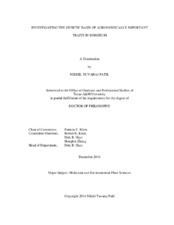| dc.contributor.advisor | Klein, Patricia E | |
| dc.creator | Patil, Nikhil Yuvaraj | |
| dc.date.accessioned | 2017-03-02T16:48:21Z | |
| dc.date.available | 2018-12-01T07:20:21Z | |
| dc.date.created | 2016-12 | |
| dc.date.issued | 2016-12-06 | |
| dc.date.submitted | December 2016 | |
| dc.identifier.uri | https://hdl.handle.net/1969.1/159031 | |
| dc.description.abstract | The genetic basis of three key agronomic traits viz. anthracnose resistance, tolerance to salinity and plant height, which affect sorghum grain, forage, and biomass production was investigated. Modern genomic tools like high-throughput genotyping, sequence-based marker technology and statistical software were used in conjunction with field or greenhouse based evaluation of recombinant inbred line (RIL) populations to identify the genomic regions and genes controlling these traits.
A total of 9 quantitative trait loci (QTL) that imparted variable levels of resistance to anthracnose, were identified from two different RIL populations. Of these QTL, three encoded stable resistance across all environments while two loci were environment specific. A brief examination of the candidate genes underlying one of the major resistance QTL revealed a block of genes that may play a role in host plant resistance. The molecular markers identified in this study serve as a tool for accelerated pyramiding of multiple anthracnose resistance loci into an elite sorghum genotype to provide effective and durable resistance. The analysis of a RIL population segregating for salt tolerance in greenhouse conditions consistently detected a QTL based on the percentage of total leaf area that was necrotic or damaged. Markers linked to the trait that could potentially be used for marker-assisted introgression of salt tolerance were identified. Of the genes observed on surveying the QTL, a cation/H^+ antiporter appears as a strong potential candidate conditioning salt tolerance to sorghum. The genomic locus controlling plant height in sorghum and harboring the dwarfing gene Dw2 was mapped at high resolution using individuals from a RIL population segregating for height. The locus was narrowed to ~0.1 Mbp and a candidate histone deacetylase gene and the molecular marker linked to this locus were identified. The functional validation of the candidate gene using Agrobacterium-mediated transformation was attempted but was not successful on account of the recalcitrance of sorghum for in vitro growth and transformation. | en |
| dc.format.mimetype | application/pdf | |
| dc.language.iso | en | |
| dc.subject | Anthracnose | en |
| dc.subject | Digital Genotyping | en |
| dc.subject | Salt tolerance | en |
| dc.subject | Dw2 | en |
| dc.title | Investigating the Genetic Basis of Agronomically Important Traits in Sorghum | en |
| dc.type | Thesis | en |
| thesis.degree.department | Horticultural Sciences | en |
| thesis.degree.discipline | Molecular and Environmental Plant Sciences | en |
| thesis.degree.grantor | Texas A & M University | en |
| thesis.degree.name | Doctor of Philosophy | en |
| thesis.degree.level | Doctoral | en |
| dc.contributor.committeeMember | Klein, Robert R | |
| dc.contributor.committeeMember | Hays, Dirk B | |
| dc.contributor.committeeMember | Zhang, Hongbin | |
| dc.type.material | text | en |
| dc.date.updated | 2017-03-02T16:48:21Z | |
| local.embargo.terms | 2018-12-01 | |
| local.etdauthor.orcid | 0000-0002-7750-4405 | |


